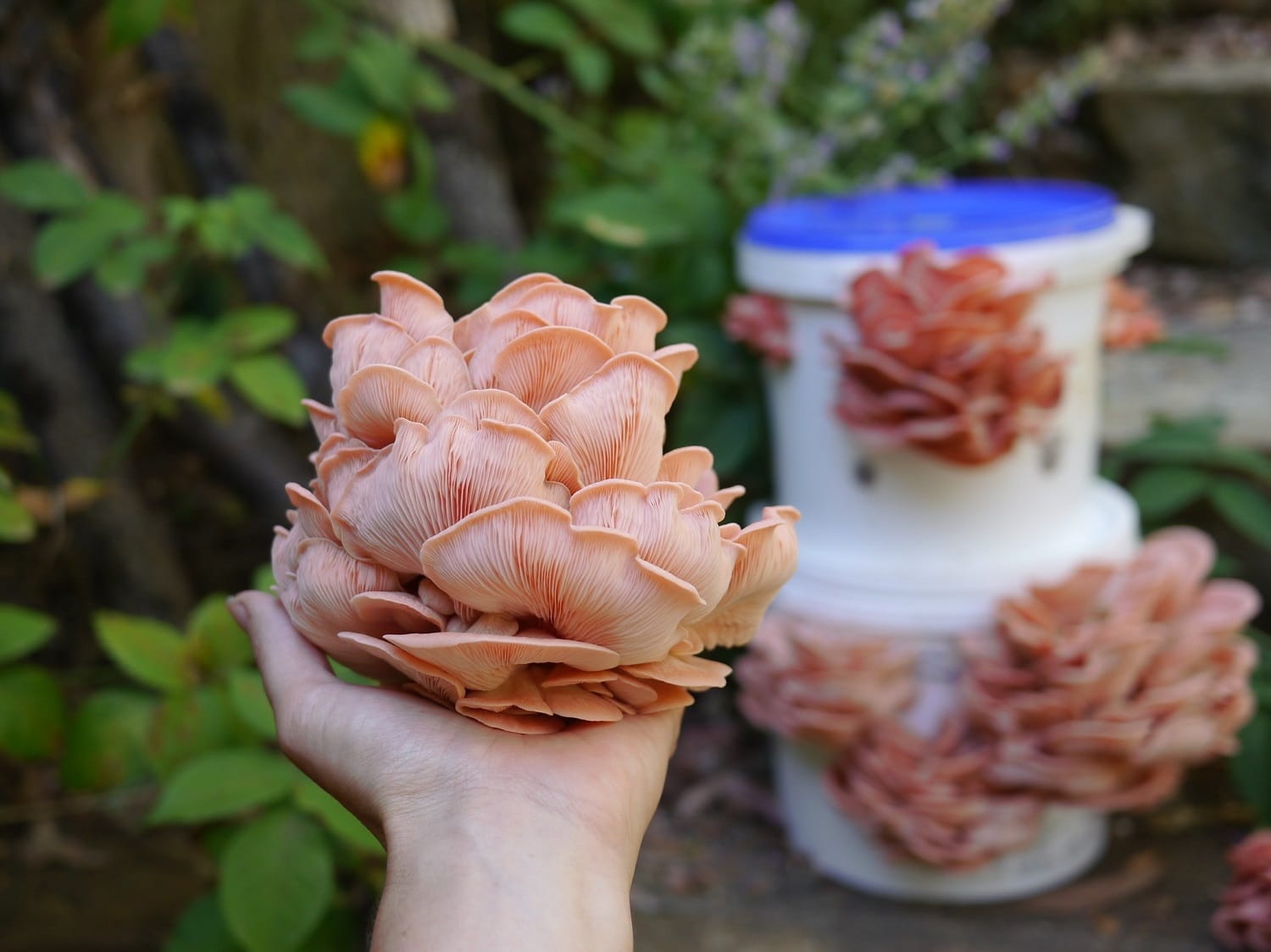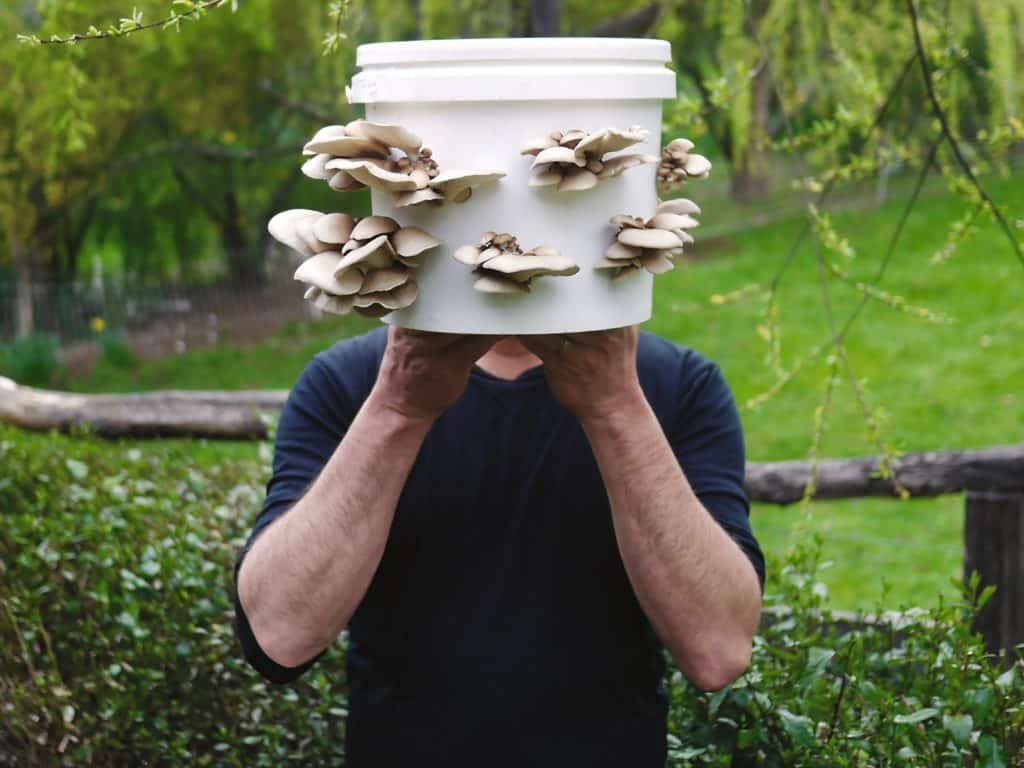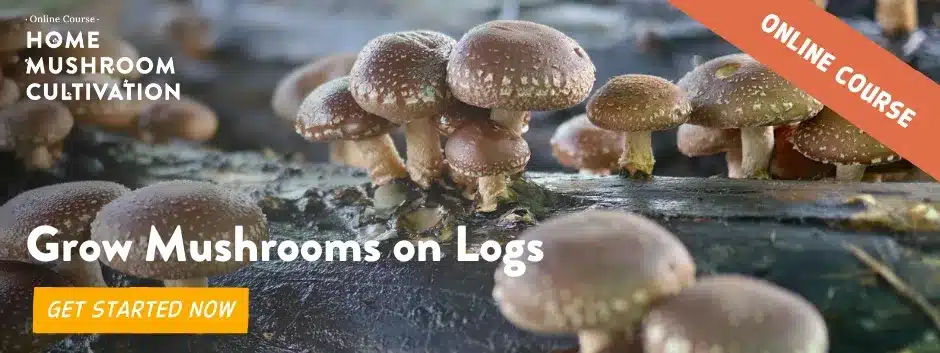

Ready to learn the way of the mushroom? Here’s a How-To for growing mushrooms in buckets at your place! Plus a beginner’s guide to fungi ID.
Fungi are an entirely separate kingdom of life – they’re not a plant, nor an animal. They’re a little bit weird and also deeply amazing. And without them, life on earth might not exist.
Mushrooms are the fruiting bodies of some types of fungi. A mushroom- producing fungi spends the majority of its life cycle hidden under, or inside, other substances – substances like wood, soil or straw – in the form of mycelium, which slowly colonises and eats that substance, before fruiting into mushrooms.
It’s thought that there are about 10,000 species of mushroom-producing fungi worldwide. Of these, about 30 species are commonly cultivated – you know, portobellos, oysters, reishi and all the rest.
So, today we have a comprehensive how-to video and TWO downloadable resources for you. But perhaps you’re ready to delve even deeper? You might like to check out our Home Mushroom Cultivation online course.
Making friends with Fungi
First off, before you start learning to forage or to cultivate mushrooms, get to know them!
It’s not necessary to forage mushrooms to begin to understand them. In fact, tuning up your powers of observation and getting your fungi ID on, is the first step to making friends with fungi, so we recommend that you start there (lots of book recommendations below), before learning which ones are good to eat, where you live.
As with any wild food, ID is crucial. Learn, read, ask, learn. Don’t ever eat a mushroom that you are not absolutely sure is an edible species.
Here’s a video lesson on all things mushroom, to lead you through the basics… plus a How-To on bucket cultivation.
Mushroom Growing & Gathering – a How-To…
Ok then… does this sound like something you’d like to do? Great! We’ve created a foraging guide and a DIY bucket cultivation guide for you, to get you started…
Cultivating mushrooms at home
Learning how to grow mushrooms from scratch is a little bit like learning a magic trick. And yet, once you have the basic skills and principles sorted out, it’s really very doable.
Fungi are both complex and simple. They need certain things to grow well, and if you don’t provide these they will sulk and produce no mushrooms. But the kingdom of fungi is also hugely generous and capable of producing incredible amounts of nutrient-rich mushrooms from simple waste substances – again, and again, and again. You just need to get to know them.
The guide above will get you started with no-waste bucket cultivation, so go read that first! After that, there’s a whole chapter on this type of mushroom cultivation in our Milkwood Book, and lots more resources below.
All the best with your adventures, and may the mycelium be with you!
And don’t forget, you can always go deeper and learn *heaps* more – supported by our team of fungi experts, via our Home Mushroom Cultivation online course. You can find out more and join our mushroom growing course waitlist here.

Here’s our live Q&A…
This Q&A was held live on our Facebook page, on Friday June 12. And be sure to check out the resources down below to help you along the way to fungi happiness.

Resources
Firstly, if you have any questions on the above, please comment below, and we will help you puzzle out an answer! Any cultivation or foraging questions you have are welcome.
ARTICLES
- All our articles and How-Tos on Mushrooms
- Our Facebook Community Group is here – ask any questions you have, and we will help you out!
- Consuming Shiitake Daily Improves Human Immunity – study showing immune boosting properties of shiitake
- Death Cap Mushrooms: What do they Look Like and Where are they Found?, ABC News – death cap mushroom, Amanita phalloides, a deadly fungus commonly mistaken for edible mushrooms
- Functional Properties of Edible Mushrooms, NCBI, Pubmed – study showing 50% of cultivated edible mushrooms contain functional ‘nutraceutical’ or medicinal properties
- Grow Mushrooms – What Is a Substrate?, Mushroom Appreciation – types of substrates you can grow mushrooms in
- Medicinal Mushrooms – links to many studies showing benefits and conditions they may help
- What is the Nutritional Value of Mushrooms?, Medical News Today – health benefits
- Wild Mushrooms: What to Eat, What to Avoid, Tom Oder, Mother Earth News – read this carefully
- Eating Fly Agaric (the red and white ones) – do your research before attempting this. They are delicious when prepared properly, however
TOURS/EVENTS
- Mushroom Foraging Tours, Diego Bonetto – NSW AU
- Workshops/Events, Alison Pouliot – VIC AU – Alison also has some rad local fungi ID guides, like this one.
WEBSITES
- Australian Wild Mushroom Hunters – excellent FB group for Australian foragers
- FungiMap – map of fungi (Australia), articles, stories etc
- The Mushroom Identification Group – US based
BOOKS
- Milkwood: Real Skills for Down-to-Earth Living, Kirsten Bradley and Nick Ritar – Chapter 2: Mushrooms
- All That The Rain Promises And More, David Arora – this is a great pocket guide to fungi. Although specific to the pacific northwest of the USA it will help you identify mushrooms wherever you are – Booktopia / Amazon
- Mushrooms Demystified, David Arora – a companion to the above book with much more detail – Booktopia / Amazon
- A Field Guide to the Fungi of Australia, Tony Young, Kay Smith – a great book to use in conjunction with the two guides above if you are in Australia – Booktopia / Amazon
- Edible Mushrooms: A Forager’s Guide to the Wild Fungi of Britain and Europe, Geoff Dann – similar great book to use with the books by Arora above – Booktopia / Amazon
Video credits…
Thank you to Dylan, our videographer. Thanks to Charlie Mgee of Formidiable Vegetable, for the music used throughout. Thanks to Brenna Quinlan for beautiful illustrations, diagrams and titles. And thanks to all the rest of our team who help make our courses and all their resources possible. You are awesome.













I’m keen to get started growing mushrooms, but a couple things holding me back. The main one is getting builders lime, as I can only find it at the big Green box in Large bags, when I only need a little.
Also trying to boil enough water to cover the substrate and carry it to my work area! Any tips greatly appreciated
I just bought 20kg at Bunnings and with a Power Pass card it was $11:something
Im happy to share
Awesome, thanks Lin
You can buy hydrated lime in small quantities via ebay.
For pasteurising you can use something like an old Fowlers Vacola preserver or an immersion element in a cooler/esky to heat water with electricity.
If you want to do it at a larger scale i have found that a fire under an oil drum works quite well.
If this becomes a regular thing for you please investigate a sustainable source of energy for heating your water.
Have fun 🙂
thank you
great video.
I have two questions:
could you boil your substrate instead of keeping it at a certain temperature in order to pasteurise?
could you use zip lock freezer plastic bags to incubate the inoculated substrate?
many thanks, Raya
Hi Raya,
Unlike sterilization, pasteurization only eliminates pathogenic microorganisms and not intends to kill all micro-organism.
If the substrate is boiled (heated over 80c) it will kill some beneficial microorganisms which can increase the likely hood that your substrate gets over-run by mould.
Zip lock bags will work, but probably only once. They are hard to clean and are easily damaged when you try to re-use them.
thank you very much! I understand about the heat sterilisation now. I have hydrated lime and would like to try substrate pasteurization via this methods: how much of Ca(OH)2 should I be using, please?
could I also be using the mycelium that has just fruited to inoculate the new substrate?
If you are using cold water you can use 1 cup of hydrated lime per 50L of water. The bonus with that method is that you can reuse the water a few times till it gets muddy.
You could use the spent mycelium to reinoculate, but the grain in the spawn is an important part of the recipe. It provides lots of sugars, proteins and nutrients that aren’t in the straw or sawdust. It will work, but you will get a significantly lower yield per bucket, less than half in my experience.
Thank you Nick, how long do I soak the straw in the lyme solution for, please?
2 hours seems to work best.
Make sure it is builder’s lime (hydrated lime, slaked lime or Ca(OH)2 ) not garden lime ( limestone, dolomite or CaCO3 ) or it will not work properly.
Are you able to use spent coffee grounds as a replacement for the sugar and proteins that come from grain? I have a starter kit that is on its last harvest and I would hate to have to buy spawn when I have a living colony
Hi Thank you for the entertaining much room vid. Two simple questions. The surgical tape you use, is that paper tape and by the time lm moisturising the air should I be sterilising the spray bottle and water? I love your book btw.
Hi Pauline,
the surgical taper is cellulose based surgical tape by 3M called “micropore” tape. It’s like paper but not quite. If you can get a more “papery” surgical tape use that. 🙂
You don’t need to sterilise the water you mist your growing mushrooms with. Once the mycelium has fully colonised the substrate it is strong enough to defend itself from moulds and bacteria.
Im ibtwrested in shifting from one use grow bags to buckets, but im reluctant on the basis o
Hi Joe, i think you got cut off… why were you reluctant?
Hi Milkwood! I was wondering if you’ve moved away from the two bucket system (posted quite a few years ago) and if so, the reasons for the move? I’d prefer to avoid the single-use micropore tape if possible, but if there’s a significant difference then I prefer a better yield 😉
hey Yvonne! The main reason we’ve moved away from the 2-bucket method is that the 2 buckets can get pretty snug, and be quite hard to remove the outer one – especially once there’s mycelium kindof gluing them together… which means that fruiting can become really tricky
If you don’t want to use micropore tape, you could just leave that off – most of the time it will still all work fine, though sometimes you’ll get some contamination – give it a go? 🙂
or use paper based masking tape.. it works OK too.
I just wanted to say thanks for all the great mushroom knowledge you have shared over the years! i have read everything multiple times. I am now picking about 1kg a week of oysters a week from my little greenhouse, using the cold-pasteurisation method, double-buckets and bought grain spawn. Next step: pressure cooker.
awesome Dan, well done
We started our mushrooms about 4 weeks ago. The mycelium has taken over, but nothing is pushing through the tape yet. Will the mushrooms be strong enough to push through once they start growing? How long do I wait before knowing something has gone wrong? Is there anything I can do to help the process?
That was fabulous thank you Nick!
🙂